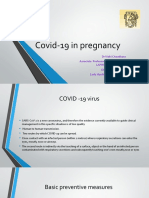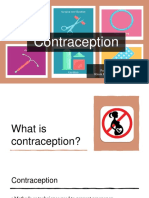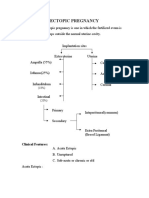Emergency Contraception
Emergency Contraception
Uploaded by
indeenikeCopyright:
Available Formats
Emergency Contraception
Emergency Contraception
Uploaded by
indeenikeCopyright
Available Formats
Share this document
Did you find this document useful?
Is this content inappropriate?
Copyright:
Available Formats
Emergency Contraception
Emergency Contraception
Uploaded by
indeenikeCopyright:
Available Formats
Emergency Contraception
DAVID G. WEISMILLER M.D., SC.M., Brody School of Medicine at East Carolina University, Greenville, North Carolina Am Fam Physician. 2004 Aug 15;70(4):707-714. Women can use emergency contraception to prevent pregnancy after known or suspected failure of birth control or after unprotected intercourse. Many patients do not ask for emergency contraception because they do not know of its availability. Emergency contraception has been an off-label use of oral contraceptive pills since the 1960s. Dedicated products, the Yuzpe regimen (Preven) and levonorgestrel (Plan B), were marketed in the United States after 1998 but had been available in Europe for years before that. A third approved method of emergency contraception is the insertion of an intrauterine device. Emergency contraception is about 75 to 85 percent effective. It is most effective when initiated within 72 hours after unprotected intercourse. The mechanism of action may vary, depending on the day of the menstrual cycle on which treatment is started. Despite the large number of women who have received emergency contraception, there have been no reports of major adverse outcomes. If a woman becomes pregnant after using emergency contraception, she may be reassured about the lack of negative effects emergency contraception has on fetal development. It may be beneficial for physicians to offer an advance prescription for emergency contraception at a patients regular gynecologic visit to help reduce unwanted pregnancies. Advance provision of emergency contraception can increase its use significantly without adversely affecting the use of routine contraception. Emergency contraception, sometimes referred to as the morning-after pill, is birth control that women can use to prevent pregnancy after known or suspected failure of contraception or unprotected intercourse, including sexual assault. Immediate use of an emergency contraceptive reduces a womans risk of pregnancy to 1 to 2 percent. The effectiveness depends on the regimen used and the time between unprotected intercourse and treatment.1 The most common reasons for seeking emergency contraception are failure of a barrier method of contraception (usually condoms) and failure to use any method.25 A national survey of women conducted by the Kaiser Family Foundation in 2003 reports that two thirds of women 18 to 44 years of age are aware of emergency contraception; only 6 percent of women reported ever having used it.6 Research analyzing abortion trends from 2000, when only 2 percent of women reported ever using emergency contraception,7 supports estimates that 51,000 abortions were prevented by emergency contraception use that year, suggesting that increased use of emergency contraception as a back-up method may have accounted for up to 43 percent of the total decline in abortion rates between 1994 and 2000.8 Strength of Recommendation SOR Key clinical recommendation labels References The levonorgestrel dose does not need to be split; a single dose of 1.5 A 10
Key clinical recommendation mg can be used. The sooner the first dose of emergency contraception is taken after A unprotected intercourse, the greater the efficacy. The incidence and severity of nausea and vomiting decrease when B antiemetic agents are taken one hour before the first contraceptive dose. Compared with the combination method, the frequency of nausea and A vomiting, dizziness, and fatigue with the progestin-only method is significantly less. There are no contraindications to the oral combination method of C emergency contraception except pregnancy. In a woman with a history of idiopathic thrombosis, the progestin- C only regimen of emergency contraception may be preferable.
SOR labels References 19 24,25 19 31 34
Widespread use of emergency contraception requires familiarity with the methods, public awareness of its availability and, in all but the six states (i.e., California, Alaska, Washington, New Mexico, Hawaii, and Maine) where it can be obtained without prescription, prompt access to a health care professional who can provide a prescription. This article outlines the evidence for the methods, safety, efficacy, risks, and benefits of emergency contraception. Methods The U.S. Food and Drug Administration (FDA) has approved three methods of emergency contraception (Table 1). The combination oral-contraceptive method (Yuzpe regimen) uses 0.1 mg of ethinyl estradiol and 1.0 mg of DL-norgestrel (equivalent to 0.5 mg of levonorgestrel) in two doses taken 12 hours apart, starting within 72 hours of unprotected sexual intercourse.5 The progestin-only method uses 0.75 mg of levonorgestrel in two doses taken 12 hours apart. The FDA has cleared 13 brands of oral contraceptives for safety and efficacy when used for emergency contraception (Table 2). TABLE 1 Approved Methods of Emergency Contraception Method Formulation and dosage Cost* Combination oral 0.1 mg ethinyl estradiol and 1.0 mg DL-norgestrel; $ 35 contraceptive two doses 12 hours apart starting within 72 hours of unprotected sexual intercourse Progestin-only oral 1.5 mg of levonorgestrel once or 0.75 mg $ 35 contraceptive levonorgestrel twice, 12 hours apart; starting within 72 hours of unprotected sexual intercourse Preven (Gyntics) 0.25 mg levonorgestrel and 0.05 mg ethinyl estradiol; $ 20 two doses 12 hours apart starting within 72 hours of unprotected sexual intercourse Plan B (Womens Capital 1.5 mg of levonorgestrel once or 0.75 mg $ 22
Method Corporation) ParaGard T-380A intrauterine copper contraceptive (Ortho)
Formulation and dosage levonorgestrel twice, 12 hours apart
Cost* $359
*Estimated cost to the pharmacist based on average wholesale prices in Red book. Montvale, N.J.: Medical Economics Data, 2004. Cost to the patient will be higher, depending on prescription filling fee. Prices are approximate, varying by brand. TABLE 2 Prescriptive Equivalents of Common Oral Contraceptives and Dedicated Products for Use as Emergency Contraception Pills per Ethinyl estradiol per dose Norgestrel per dose Agent dose* (mcg) (mg) Ovral 2 white 100 1 Alesse 5 pink 100 0.50 Levlite 5 pink 100 0.50 Nordette 4 light-orange 120 0.60 Levlen 4 light-orange 120 0.60 Levora 4 white 120 0.60 Lo/Ovral 4 white 120 1.2 Triphasil 4 yellow 120 0.50 Tri-Levlen 4 yellow 120 0.50 Trivora 4 pink 120 0.50 Ogestrel 2 100 1 Low-Ogestrel 4 120 1.2 Ovrette 20 yellow 0 1.5 Dedicated products Preven 2 blue 100 0.5 Plan B 1 white 0 0.75 *The progestin in Ovral, Lo/Ovral, Ovrette, Ogestrel, and Low-Ogestrel is norgestrel, which contains two isomers, only one of which (levonorgestrel) is bioactive; the amount of norgestrel in each tablet is twice the amount of levonorgestrel. Treatment consists of two doses taken 12 hours apart. In 1998, two prescription formulations specifically intended for emergency contraception became available: Preven and Plan B. The Preven Emergency Contraceptive Kit (Yuzpe regimen) consists of four pills, each containing 0.25 mg of levonorgestrel and 0.05 mg of ethinyl estradiol; a urine pregnancy test; and a patient information book.
The Plan B option consists of two tablets, each containing 0.75 mg of levonorgestrel.9 (This amount differs from the 0.075-mg dose of norgestrel in certain progestin-only pills.) Detailed patient and physician labeling accompanies both methods. There is a general consensus10,11 that the levonorgestrel emergency contraception should be given in preference to the Yuzpe regimen where available because it is more effective and has fewer side effects. In addition, a World Health Organization (WHO) multicenter randomized trial12 shows that the levonorgestrel dose does not have to be split but can be taken as a single 1.5-mg dose. One dose simplifies the use of levonorgestrel without causing an increase in side effects. An alternative to the hormonal methods is insertion of the ParaGard T-380A Intrauterine Copper Contraceptive up to five days after unprotected intercourse. After insertion for the purpose of emergency contraception, this device can provide reversible contraception for up to 10 years. Mechanisms of Action A single mechanism of action has not been identified.13 Inhibition or delay in ovulation and insufficient corpus luteum function have been reported in some women.14 Some studies have reported histologic or biochemical changes within the endometrium that may result in failure of implantation.15,16 Another study suggests that the mechanism of action is interference with tubal transport of sperm, egg, or embryo.17 There is no evidence that emergency contraception increases the incidence of ectopic pregnancy; however, no studies specifically focus on this issue. Although the predominant mode of action of combination hormonal contraceptives is most likely ovulation suppression, this effect is not total.18 Breakthrough ovulation is estimated to occur in up to 10 percent of cycles. Other mechanisms of action (changes in cervical mucus and the endometrium) are recognized and included in the prescribing information. Endometrial changes make implantation after fertilization less likely and, depending on when the hormones are taken, may be the more common mechanism. However, how often a post-fertilization effect occurs is unknown.19 Timing There is an inverse relationship between prevention of pregnancy and time since unprotected intercourse (Figure 1).20 This upward gradient between 24, 48, and 72 hours is true for both hormonal methods, and particularly for the progestin-only method. In almost all studies, the first dose is administered within 72 hours after unprotected intercourse. A recent multicenter, randomized controlled study found that the sooner the first dose was taken after intercourse, the greater the effectiveness.21 The failure rate at 72 hours (three days) after hormonal emergency contraception is approximately 4 percent. This rate increases to 10 percent at five days.20,21
Figure 1 Effect of time of the first dose of emergency contraception on pregnancy rate. Adapted with permission from Piaggio G, von Hertzen H, Grimes DA, Van Look PF. Timing of emergency contraception with levonorgestrel or the Yuzpe regimen. Task Force on Postovulatory Methods of Fertility Regulation. Lancet 1999;353:721. Some authors suggest that emergency contraception may have some benefit beyond 72 hours after unprotected intercourse,2224 but that option should be evaluated for each patient. The data do not suggest that use of oral contraceptives can interrupt an established pregnancy. Insertion of an intrauterine device (IUD) represents an alternative that may be effective five to seven days after unprotected intercourse except in cases of known sexually transmitted infection or rape (because of the potential for sexually transmitted infection).25 Adverse Effects Nausea occurs in 30 to 60 percent of patients who use combination oral contraceptives for emergency contraception. It may occur after either dose of medication and tends to last no more than two days. Emesis occurs in 12 to 22 percent of patients. The incidence and severity of nausea and vomiting decrease when antiemetic agents are taken one hour before the first emergency contraceptive dose is taken.26,27 Antiemetic agents do not seem to be effective if taken only after the onset of nausea and vomiting.
Compared with the combination method, the frequency of nausea and vomiting with the progestin-only method is significantly lower. This difference also is true for dizziness and fatigue.21 There is no evidence that emesis within three hours of ingesting the dose is associated with an increased failure rate; however, none of the studies reported was designed to measure this effect. There is limited evidence on which to base a recommendation for repeating the dose if emesis occurs. If vomiting occurs within one hour after taking either dose, repeat dosing may be considered. However, it seems reasonable to infer that if gastrointestinal symptoms are estrogen-mediated secondary to an effect on the central nervous system, absorption of the dose should have occurred by the time of emesis. Effectiveness All three types of emergency contraception are highly effective in preventing pregnancy after unprotected intercourse. It has been estimated that widespread use of emergency contraception could reduce unintended pregnancies in the United States by one half, which translates to 1.5 million fewer unintended pregnancies. Based on this projection, the number of elective terminations also could be reduced by one half, potentially resulting in 700,000 fewer abortions.28,29 Two reviews30,31 of the published literature concluded that the effectiveness rate of the combination method ranges between 55 and 94 percent, with a weighted average of 70 to 74 percent. Because the observed number of pregnancies in these studies is likely to be underestimated, the true effectiveness rate is likely to be at least 75 percent. It is important to communicate to patients that these numbers do not translate into a pregnancy rate of 25 percent. Rather, they mean that if 1,000 women have unprotected intercourse in the middle two weeks of their menstrual cycles, approximately 80 will become pregnant. Use of emergency contraceptive pills would reduce this number by 75 percent, to 20 women(Table 3). TABLE 3 Emergency Contraception Effectiveness* Method Number of pregnanciesReduction (%) No treatment 80 Combined 20 75 Progestin-only 10 88 Intrauterine device insertion1 99 *If 1,000 women have unprotected intercourse once in the second or third week of their cycle. The progestin-only method appears to be more effective in preventing pregnancy than the combination-pill method. In a randomized, double-blind trial,21 the proportion of pregnancies prevented with the progestin-only method was 85 percent compared with 57 percent with combination oral contraceptives. Between the two methods, the crude relative risk of pregnancy was 0.36, a significant difference.21 Although all of these
methods reduce the risk of pregnancy, they are less effective than consistent use of methods intended specifically for routine contraception (Table 4). TABLE 4 First-Year Failure Rate of Family Planning Methods Lowest observed failure Methods rate (%) Tubal sterilization 0.3 Vasectomy 0.4 Injectable progestin (DEPO) 0.3 Progestin implant (Norplant) 0.09 Combined oral contraceptive pill 0.1 Progestin-only pill 0.5 Copper T-380A intrauterine device 0.6 Condom Male 3 Female 5 Diaphragm (with spermicide) 6 Patch 1 Ring 0.7 Cervical cap 11.5 Foams, creams, etc. 6 Coitus interruptus (withdrawal) 16 Fertility awareness techniques 2 (e.g., rhythm) Douche Chance (no method of birth 85 control) Teratogenic Effects The limited data on teratogenic effects come from a relatively small number of reports in which treatment was not successful, and the woman elected to continue the pregnancy. No evidence exists of a specific syndrome of anomalies or an apparent increase in the incidence of anomalies. It is important to recognize that no studies have investigated teratogenic effects associated with the use of oral emergency contraception. Numerous studies of the teratogenic risk of conception during the routine use of oral contraceptives, including the older, high-dose preparations, found no increase in risk.32 Contraindications The WHO33 has concluded that there are no contraindications to the oral combination method of emergency contraception except pregnancy. The American College of Obstetricians and Gynecologists34 states that emergency oral contraception should not be used in a patient with a known or suspected pregnancy, hypersensitivity to any component of the product, or undiagnosed abnormal genital bleeding. Adverse events
Failure rate intypical user (%) 0.3 0.4 0.3 0.09 3 3 0.8 12 21 18 3 3 18 21 23 24 40 85
associated with oral emergency contraception, such as effects listed with the known contraindications to daily use of combination birth-control pills, have not been reported in published studies using evidence-based criteria. In addition, there is no evidence relative to increased risk or safety in women who have contraindications to the use of daily oral contraceptives. The daily dose of steroid hormones in the hormonal methods of emergency contraception is greater than that used for routine oral contraception; however, the duration of use in the latter case is short.35 In a woman with a history of idiopathic thrombosis, the progestin-only regimen may be preferable.36 Starting or Resuming a Routine Contraceptive Method One important issue for patients following emergency contraception therapy is starting a routine contraceptive method. Patients can start hormonal contraception immediately following emergency contraception or wait until the next menstrual period. Table 5 outlines options for beginning a family planning method following the use of emergency contraception. TABLE 5 Beginning a Family Planning Method after Emergency Contraception Method Regular start Jump start Reminders Oral Use back-up Start a new package of oral Perform contraceptives contraception contraceptives the day after taking pregnancy test if (combination or method until next the two emergency contraception patient does not progestin-only) period, then begin doses (use back-up contraception have a normal oral contraceptive method for first seven days). period after pills according to completing first regular patient package of pills. instructions. Injectable Use back-up Start either injectable method the contraceptives contraception day after taking the two (combination or method until next emergency contraception doses progestin-only) period, then start (use back-up contraception either injectable method for first seven method according to days).Modified jump start: start regular patient oral contraceptives the day after instructions. taking the two emergency contraception doses (use back-up contraception method for first seven days); start injectable contraceptive after next period (use back-up contraception method for first seven days). Combination Use back-up Apply the patch the day after Perform patch contraception taking the two emergency pregnancy test if
Method
Regular start method until next period, then begin patch according to regular patient instructions.
Jump start contraception doses (use back-up contraception method for first seven days).
Intrauterine device (IUD)
Diaphragm Condoms Spermicides
Use back-up contraception method until next period, then proceed with IUD insertion. Begin using immediately. Begin using immediately. Begin using immediately.
Reminders patient does not have a normal period after completing a one-month supply
After using emergency oral contraception, up to 98 percent of patients menstruate within 21 days of treatment.5 In more than one half of patients, menses occurs at the expected time.20 In more than 90 percent of cases, menses will be of normal (for that woman) duration. Whether the patient has a history of regular or irregular menstrual cycles does not appear to be a contributing factor.5 If the emergency contraception treatment is given before ovulation, menstrual bleeding may begin three to seven days earlier than expected. If the treatment begins after ovulation, menstrual bleeding may come at the expected time or be delayed.3,21 It is important for the patient to seek prompt medical care if menses has not started within 21 days. Advance Provision Three studies have found that advance provision results in greater use of emergency contraception. A Scottish study37 of more than 1,000 women compared advance provision with counseling about oral emergency contraception and how to obtain it (i.e., by visiting a physician). The study found no evidence that advance provision negatively affected womens contraceptive behaviors. Most women used emergency contraception pills correctly, including many who were recruited after they had an abortion and women who had never used contraception before. Although the difference in pregnancy rates between the two groups was not statistically significant, the authors concluded that advance provision does no harm and could help prevent pregnancy. In a San Francisco study38 of more than 200 participants, women were systematically assigned to receive an advance prescription for emergency contraception and education (treatment group) or education only (control group). Providing emergency contraception in advance, but not education alone, increased the use of emergency contraception. Results of one study39 found that advance provision of emergency contraception
significantly increased its use without adversely affecting the use of routine contraception. The study designs and sample sizes are not adequate to demonstrate definitive impact on rates of unintended pregnancy. It may be beneficial for physicians to offer an advance prescription for emergency contraception to patients at regular gynecologic visits to help reduce unwanted pregnancies. Health care professionals have an important role to play in conveying information about emergency contraception (Table 6).40 TABLE 6 Emergency Contraception Resources Emergency contraception hotline 888-NOT-2-LATE Publications Emergency contraception: client materials for diverse audiences. Seattle, Wash.: Program for Appropriate Technology in Health (PATH), 1998. Available to download from the PATH Web site at http://www.path.org/resources/ec_client-mtrls.htm. Web sites PATH (Program for Appropriate Technology in Health): http://www.path.org/index.htm Emergency Contraception: http://not-2-late.com Access In 1998, Washington became the first state to allow women to obtain emergency contraception through a pharmacist without a visit to a doctor. Washingtons pilot project set up collaborative drug therapy agreements between doctors and pharmacies based on prescriptive protocols. Under the agreements, pharmacists were able to dispense emergency contraception to women who met screening criteria outlined in the protocols. The Washington program has become a model for other states. Pharmacy access to emergency contraception is now available in California, Alaska, Maine, New Mexico, and Hawaii.41 Advocates for women who have been sexually assaulted have been concerned about the failure of hospital emergency departments to make emergency contraception a standard practice of care. In 2001, Illinois became the first state to legislate on this issue, enhancing a law requiring hospitals to provide rape survivors with medically accurate information about emergency contraception. Six additional states now require that emergency department staff provide information about emergency contraception or offer the pills to women who have been sexually assaulted (i.e., California, New Mexico, New York, Ohio, South Carolina, and Washington).41 A bill has been introduced in Congress (HR2527) that would require emergency departments in all states to provide emergency contraception to women in all cases of sexual assault. On February 14, 2001, the Center for Reproductive Rights petitioned the FDA to make emergency contraception available on an over-the-counter basis. In December 2003, two FDA advisory panels endorsed switching Plan B to over-the-counter status. On May 6, 2004, the FDA denied over-the-counter status for Plan B emergency contraception. The
decision was based primarily on inadequate data supporting the conclusion that Plan B can be used safely by adolescent women for emergency contraception without the supervision of a health care professional.
You might also like
- (International Handbooks of Population - 11) John F. May, Jack A. Goldstone - International Handbook of Population Policies-Springer (2022)Document862 pages(International Handbooks of Population - 11) John F. May, Jack A. Goldstone - International Handbook of Population Policies-Springer (2022)Kalsoom100% (1)
- Programs of Doh - NCDDocument71 pagesPrograms of Doh - NCDZOVELLA AURORA M. ACURAMNo ratings yet
- 39-Assessment of Fetal Well BeingDocument34 pages39-Assessment of Fetal Well Beingdr_asalehNo ratings yet
- Health Promotion ModelDocument43 pagesHealth Promotion ModelJinsha Sibi86% (7)
- Family Welfare ProgrammeDocument22 pagesFamily Welfare ProgrammeTejal Gound92% (12)
- Preconceptional CareDocument22 pagesPreconceptional CareSantosh KumariNo ratings yet
- Emergency ContraceptionDocument6 pagesEmergency ContraceptionAHm'd MetwallyNo ratings yet
- Preventive ObstetricsDocument57 pagesPreventive ObstetricsGunaNo ratings yet
- Thyroid Disease in PregnancyDocument36 pagesThyroid Disease in Pregnancypeni_dwiNo ratings yet
- CTG Booklet: A Quick Reference Guide For Managing CtgsDocument16 pagesCTG Booklet: A Quick Reference Guide For Managing Ctgscirlce:twoworldsconnectedNo ratings yet
- OxytocinDocument1 pageOxytocinSubbie OutlierNo ratings yet
- Labour, Neonate & PuerperiumDocument550 pagesLabour, Neonate & PuerperiumJonah nyachaeNo ratings yet
- Covid in PregnancyDocument30 pagesCovid in Pregnancyvidhi chaudharyNo ratings yet
- Contraception: DR Husni SamarahDocument15 pagesContraception: DR Husni Samarahpal_pal_palNo ratings yet
- Thyroid Disorders in PregnancyDocument17 pagesThyroid Disorders in PregnancyFemale calmNo ratings yet
- M.M. College of Nursing: Assignment ON Different Signs During PregnancyDocument4 pagesM.M. College of Nursing: Assignment ON Different Signs During PregnancyNadiya RashidNo ratings yet
- Case Presentation CPD New 1.1Document57 pagesCase Presentation CPD New 1.1merapi mountainNo ratings yet
- Fertilisation Implantation NotesDocument4 pagesFertilisation Implantation NotesShaun JinNo ratings yet
- Seminar On Postpartum Haemorrhage, Retained Placenta, Placenta Accreta and Role of Nurse in Critical Care in ObstetricsDocument11 pagesSeminar On Postpartum Haemorrhage, Retained Placenta, Placenta Accreta and Role of Nurse in Critical Care in ObstetricsScott MonroeNo ratings yet
- Skills Training Manual BookDocument51 pagesSkills Training Manual BookAndi RahmaNo ratings yet
- Low Amniotic Fluid LevelsDocument2 pagesLow Amniotic Fluid LevelspramaNo ratings yet
- PPIUCD Reference ManualDocument81 pagesPPIUCD Reference ManualNeha100% (1)
- Psychological and Social Aspect of MenopauseDocument16 pagesPsychological and Social Aspect of MenopauseFarheen khanNo ratings yet
- Contraception: Teoh Huey Ching Pegawai Farmasi UF41 Klinik Kesihatan Durian TunggalDocument30 pagesContraception: Teoh Huey Ching Pegawai Farmasi UF41 Klinik Kesihatan Durian TunggalThe CharzNo ratings yet
- Ectopic Pregnancy: Definition: An Ectopic Pregnancy Is One in Which The Fertilized Ovum IsDocument4 pagesEctopic Pregnancy: Definition: An Ectopic Pregnancy Is One in Which The Fertilized Ovum IsSuhas IngaleNo ratings yet
- Ovarian Cysts: Presented by Neha Barari Assistant Professor SNSRDocument52 pagesOvarian Cysts: Presented by Neha Barari Assistant Professor SNSRBhawna JoshiNo ratings yet
- OB CH20 NotesDocument16 pagesOB CH20 NotesVeronica EscalanteNo ratings yet
- LegalaspectsDocument47 pagesLegalaspectssanthiyasandy100% (1)
- Iud (Intra Uterine Device)Document10 pagesIud (Intra Uterine Device)Rani ArsopistaNo ratings yet
- Menopause Semester 6 (IMTU)Document37 pagesMenopause Semester 6 (IMTU)nyangaraNo ratings yet
- Lesson Plan On Age-Related-Geriatrics-ProblemDocument11 pagesLesson Plan On Age-Related-Geriatrics-Problemmohamad dildarNo ratings yet
- Teaching Plan MNSG Breast FeedingDocument6 pagesTeaching Plan MNSG Breast FeedingKevin VinzNo ratings yet
- Preconception Care: Maximizing The Gains For Maternal and Child HealthDocument15 pagesPreconception Care: Maximizing The Gains For Maternal and Child HealthAnita Rezeki Carolina100% (1)
- Trends in NursingDocument30 pagesTrends in NursingRajaNo ratings yet
- Breast FeedingDocument76 pagesBreast FeedingSanjeet DuhanNo ratings yet
- Diet During PregDocument10 pagesDiet During Pregkailash atal0% (1)
- Health Talk On EclampsiaDocument17 pagesHealth Talk On Eclampsianathsujitkr1980No ratings yet
- Antenatal CareDocument82 pagesAntenatal Caremdasad18No ratings yet
- High Risk in PregnancyDocument3 pagesHigh Risk in PregnancyPrince Rudy DoctoleroNo ratings yet
- The High Risk New BornDocument23 pagesThe High Risk New Bornchhaiden100% (4)
- Pregnant Abdomen ExamDocument4 pagesPregnant Abdomen ExamAmiel Francisco ReyesNo ratings yet
- Neonatal PneumoniaDocument16 pagesNeonatal Pneumoniaelyuchan100% (1)
- Alzhymas DiseaseDocument12 pagesAlzhymas Diseasekids dance BNo ratings yet
- CordocentesisDocument6 pagesCordocentesisAyna Salic Pangarungan100% (1)
- Menstrual Disorders: A) Primary Dysmenorrhea. Primary Dysmenorrhea Is Cramping Pain Caused by Menstruation. TheDocument7 pagesMenstrual Disorders: A) Primary Dysmenorrhea. Primary Dysmenorrhea Is Cramping Pain Caused by Menstruation. Thelaiba.akhtarNo ratings yet
- Case Presentation (Breast Engorgement)Document17 pagesCase Presentation (Breast Engorgement)mehul5460No ratings yet
- Brest Feeding - FinalDocument25 pagesBrest Feeding - FinalPranabh KushwahaNo ratings yet
- AbortionDocument19 pagesAbortionGomez VanessaNo ratings yet
- Government College of Nursing:, Jodhpur (Raj.)Document6 pagesGovernment College of Nursing:, Jodhpur (Raj.)priyankaNo ratings yet
- Introduction To ChemotherapyDocument15 pagesIntroduction To ChemotherapyHitesh ChandpaNo ratings yet
- Minor Disorder in PregnancyDocument34 pagesMinor Disorder in PregnancyChristianahNo ratings yet
- 04 Oxytocics Group ADocument53 pages04 Oxytocics Group AKamal GhimireNo ratings yet
- Puerperal SepsisDocument22 pagesPuerperal SepsisSuhas IngaleNo ratings yet
- 2diagnosisofpregnancy 150816204237 Lva1 App6892Document44 pages2diagnosisofpregnancy 150816204237 Lva1 App6892Jisha Singh100% (1)
- Antenatal CareDocument4 pagesAntenatal Caredrfaruqui2551100% (2)
- E Lert OT LarmedDocument54 pagesE Lert OT LarmedJetty Elizabeth JoseNo ratings yet
- Postpartum Care: PuerperiumDocument4 pagesPostpartum Care: PuerperiumBenedict Paul RaguntonNo ratings yet
- Dysfunctional Labour by Abhishek JaguessarDocument34 pagesDysfunctional Labour by Abhishek Jaguessarreedoye21No ratings yet
- Vaginal ExaminationDocument16 pagesVaginal ExaminationVarna MohanNo ratings yet
- Before Starting The Presentation, I Am Requesting You All To Get A HandkerchiefDocument35 pagesBefore Starting The Presentation, I Am Requesting You All To Get A HandkerchiefOng KarlNo ratings yet
- Audio Visual AidsDocument9 pagesAudio Visual AidsparthibaneNo ratings yet
- ALZHEIMERSDocument16 pagesALZHEIMERSKathleen DiangoNo ratings yet
- 001hypertensive Disorders in Pregnancy PDFDocument23 pages001hypertensive Disorders in Pregnancy PDFRosechelle Bas SamsonNo ratings yet
- Role of Dietary Fibers and Nutraceuticals in Preventing DiseasesFrom EverandRole of Dietary Fibers and Nutraceuticals in Preventing DiseasesRating: 5 out of 5 stars5/5 (1)
- Session I: Characteristics of Progestin-Only InjectablesDocument11 pagesSession I: Characteristics of Progestin-Only InjectablesRazaria DailyneNo ratings yet
- Environmental Studies Unit 5Document16 pagesEnvironmental Studies Unit 5manojboddepalli2006No ratings yet
- Unpf 0063Document142 pagesUnpf 0063Witness Wii MujoroNo ratings yet
- Population Policies in Indi1Document8 pagesPopulation Policies in Indi1LovelyNo ratings yet
- Family PlanningDocument42 pagesFamily PlanningRendy BayhaqiNo ratings yet
- Family Planning 2020Document70 pagesFamily Planning 2020Seriel TismoNo ratings yet
- 7.recent Advances in Contraceptive TechnologyDocument25 pages7.recent Advances in Contraceptive TechnologyVeena Dalmeida100% (2)
- What Is OverpopulationDocument19 pagesWhat Is OverpopulationChantal Yvette FregillanaNo ratings yet
- Abortion Womens Clinic in Randburg 0736613276Document2 pagesAbortion Womens Clinic in Randburg 0736613276MaamaTitiNo ratings yet
- Abortion Rights in AmericaDocument7 pagesAbortion Rights in AmericaBrija PatelNo ratings yet
- Unmet FormDocument2 pagesUnmet FormHan Nah Ju Deah100% (3)
- MAPEH 2ndQ Grade 8Document15 pagesMAPEH 2ndQ Grade 8Jihil KishaNo ratings yet
- Abortion Law Policy and Services in India A Critical ReviewDocument9 pagesAbortion Law Policy and Services in India A Critical ReviewAhkam KhanNo ratings yet
- Counselling For STI/HIV Prevention in Sexual and Reproductive Health SettingsDocument60 pagesCounselling For STI/HIV Prevention in Sexual and Reproductive Health SettingsLucia TrascaNo ratings yet
- The Responsible Parenthood and Reproductive Health LawDocument2 pagesThe Responsible Parenthood and Reproductive Health LawManz ManzNo ratings yet
- Entrep Act - QuizzesDocument22 pagesEntrep Act - QuizzesKatrina CaveNo ratings yet
- Chapter IDocument38 pagesChapter ILouresa Mae TNo ratings yet
- Patients Rights: Presented By: Ederlyn Papa-Destura, RN, ManDocument57 pagesPatients Rights: Presented By: Ederlyn Papa-Destura, RN, ManteuuuuNo ratings yet
- Family Planning: Having A Plan Always Helps. Planning A Family Makes Everyone Have A Decent LifeDocument2 pagesFamily Planning: Having A Plan Always Helps. Planning A Family Makes Everyone Have A Decent LifePaula AstudilloNo ratings yet
- Lectur 3FPDocument31 pagesLectur 3FPademabdella38No ratings yet
- Ielts Practice Material Handout Ren VersionDocument17 pagesIelts Practice Material Handout Ren VersionsajidNo ratings yet
- Levonorgestrel Intrauterine System: DescriptionDocument3 pagesLevonorgestrel Intrauterine System: DescriptionCECILIA AGUILARNo ratings yet
- Selam - Repaired - PDFDocument43 pagesSelam - Repaired - PDFaakumaNo ratings yet
- WHO MEC-wheel PDFDocument8 pagesWHO MEC-wheel PDFBillyNicolasNo ratings yet
- National Family Welfare ProgramDocument27 pagesNational Family Welfare ProgramBhawna JoshiNo ratings yet
- Imo State Family Planning Costed Implementation Plan (2021-2024)Document101 pagesImo State Family Planning Costed Implementation Plan (2021-2024)Emmanuel EmesowumNo ratings yet

























































































